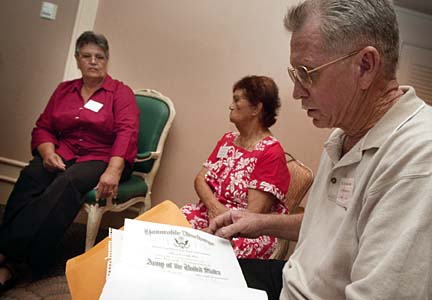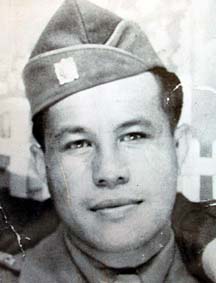
DENNIS ODA / DODA@STARBULLETIN.COM
Jeanette Chun, left, and her parents, David and Mary Lum, proudly hold a picture of brother and son 1st Lt. David Lum in front of his F4-C Phantom jet. David was shot down over the South China Sea on Dec. 20, 1966, and was reported missing in action on his 83rd mission at the age of 26.
The search
for closureFamilies of servicemen listed as
missing in action hear about
efforts to bring them home
Jeanette Chun shivers every time she thinks about that December afternoon 38 years ago when she saw two Air Force officers standing outside the screen door of her McCully home.
"It was a chilling, chilling experience," said Chun, recalling the moment just before she was told that her brother's F4-C Phantom jet went down in the China Sea during the Vietnam War. "No words were spoken, but in that split instant I knew. I just knew something terrible had happened."
Air Force 1st Lt. David Anthony Lum, 26, had "already completed 100 missions," Chun said, "but due to the shortage of pilots, his squadron was asked to go back for one last tour."
Lum, a stellar varsity basketball player on Maryknoll School's 1958 team, had earned a Distinguished Flying Cross and was supposed to be sent to California to become an instructor pilot when he was reported missing on Dec. 20, 1966.
Chun joined 27 other island families recently at a Department of Defense Prisoner of War/POW Missing Personnel Office briefing. It was one of 10 sessions the Pentagon holds annually throughout the country to keep families informed of what is being done to account for those still listed as missing in action. The previous briefing in Hawaii was two years ago. The families represented 12 MIA Hawaii cases from the Korean War and two from Vietnam.
About 8,100 servicemen are still missing from the Korean War, 78,000 from World War II, 1,869 from the Vietnam War, and 126 from the Cold War.
RICHARD WALKER / RWALKER@STARBULLETIN.COM
Francis Hapenney looked over letters from Cpl. Sidney K. Kaui after a briefing by the Department of Defense Prisoner of War/POW Missing Personnel Office at the Hilton Hawaiian Village. Kaui's sister Elsie A. Pahia, center, and her daughter Patsy Hapenney (Francis' wife) are at left.
Jerry Jennings, deputy assistant secretary of defense for the POW/MIA Office, said the United States is planning five recovery operations in North Korea this year.
COURTESY PHOTO
Cpl. Sidney K. Kaui
Since 1996, U.S. and North Korean teams have conducted 27 recovery operations in North Korea and found remains believed to be those of 180 servicemen. More recovery operations are planned in Unsan, about 60 miles south of Pyongyang near the Chosin Reservoir, which was the scene of heavy fighting when China entered the war in December 1950.
In another of America's wars, Army Cpl. Sidney Kealakai Kaui, who had been drafted out of the taro fields of Kauai and survived the Pacific battles of World War II, was in Japan and was planning to come home in November 1950.
However, Kaui, 26, was transferred to the 32nd Infantry Regiment, 7th Division and on Dec. 2, 1950, at the battle of Chosin Reservoir he became one of 73 Korean War soldiers from Hawaii listed as missing in action. He was believed to have been killed as the elements of the 32nd Infantry were withdrawing from the Chosin Reservoir.
Hawaii Army National Guard Sgt. 1st Class Francis Hapenney, a Vietnam War veteran, acknowledged that even after 32 years of service he didn't realize the effort to account for those missing in action from all of America's conflicts beginning with World War II. He said he was impressed that the Pentagon was still active pursuing the case of Kaui, his wife's uncle.
Patsy Hapenney, Kaui's niece, said she never knew her "Uncle Sidney," but the briefing gave her and her family hope that his remains may be recovered.
"I didn't know it was possible," said Patsy Hapenney, who had never heard of the Pentagon's MIA recovery efforts until last month and is now representing the Kaui family. "Now there is hope that something might happen. Until now I didn't know that so much was being done."
"They are requesting samples of our DNA," she said. Chun also has agreed to be a DNA donor.
Since the mid-1980s, deoxyribonucleic acid (DNA) has become an important tool for the forensic investigators at the Central Identification Laboratory, now called the Joint POW/MIA Accounting Command, at Hickam Air Force Base, along with dental and fingerprint records to identify the missing. Sometimes only small skeletal or dental remains are recovered.
Chun said when the 1991 Gulf War broke out, her brother's son, Stuart, had already joined the Air Force like his father. Her brother's daughter, Stephanie, who was only 8 months old when her father was reported missing, also was an officer in the Army.
Even her son, David, who was named after her missing brother, also chose to serve in the Gulf War as a Kiowa helicopter scout. "I didn't want him to join the military," Chun said, "but that is something he always wanted to do."
Ever since that December morning in 1966, Chun said: "My heart goes out to all the world who have lost a loved one whether it is in battle, an accident, kidnapping or whatever. The feelings of survivors are universal ... someone close to you is gone. We all grieve no matter what country we belong to, no matter what color of skin we have ... we grieve."
Jennings said the U.S. government is still trying to get approval to use Navy vessels to search for lost aircraft in waters off Vietnam.
Chun realizes the task of recovering her brother's remains may be slim. "I know my brother is gone," she said. "But I support the program. So many people forget, but they are not forgotten."
Elsie Kaui Pahida said there is no grave on Kauai for her brother, the eldest son of family of 12 children who grew up helping their parents, David and Wilhelmina Kaui, tending taro patches at Keahapana near Kapaa.
"But his name is among those listed as missing in action at Punchbowl and the state Korean and Vietnam War Memorial," she added, "and we did hold a memorial service for him at the Mormon Church in Kapaa in September 1953.
"He was a very good boy. He worked until he was drafted along with his brother. He was always worried about his family and always talked about sending money home to them."
But even as Francis and Patsy Hapenney found comfort that the remains of her uncle may possibly be returned, their thoughts are on another war.
As early as this month they will send three family members to Iraq -- a son, Sgt. Ernest Hapenney and nephew, Pfc. Lowen Cabuag with the Hawaii Army National Guard's 193rd Aviation Regiment and a niece, Staff Sgt. Tricia Champagne with the Army Reserve's 411th Engineer Combat Battalion.


